Best Unvented Water Heater For Residential Use
Unvented water heaters are the best choice for modern kitchens, cloakrooms and bathrooms. They’re reliable, low-maintenance, and offer cost-effective heating solutions to any points of use which are isolated from the central boiler.
Today, we are taking a look at seven of the top-rated ventless water heating systems on the market. We analyse each according to their value for money and relative pros and cons. Further down the page, we offer supplemental information on why unvented water heaters may be the superior choice over vented systems, as well as how to pick the best unit for your needs.
The best unvented water heater for money
Here, we offer up seven recommendations for unvented water heating systems, each outstanding its own niche. We review these products for their performance, maintenance requirements, energy efficiency, safety, and more. Read each carefully to decide which may be the best for your home or property.
1. Stiebel Eltron DHC-E8/10
The DHC-E8/10 from Stiebel Eltron is a something of an industry standard, and for good reason. This unvented water heater installs easily, with no need for safety valves, non-return valves, or tundish valves. Once in, however, these units tend to last for decades, requiring little in the way of maintenance. Thus, they appear frequently in both residential and commercial buildings alike.
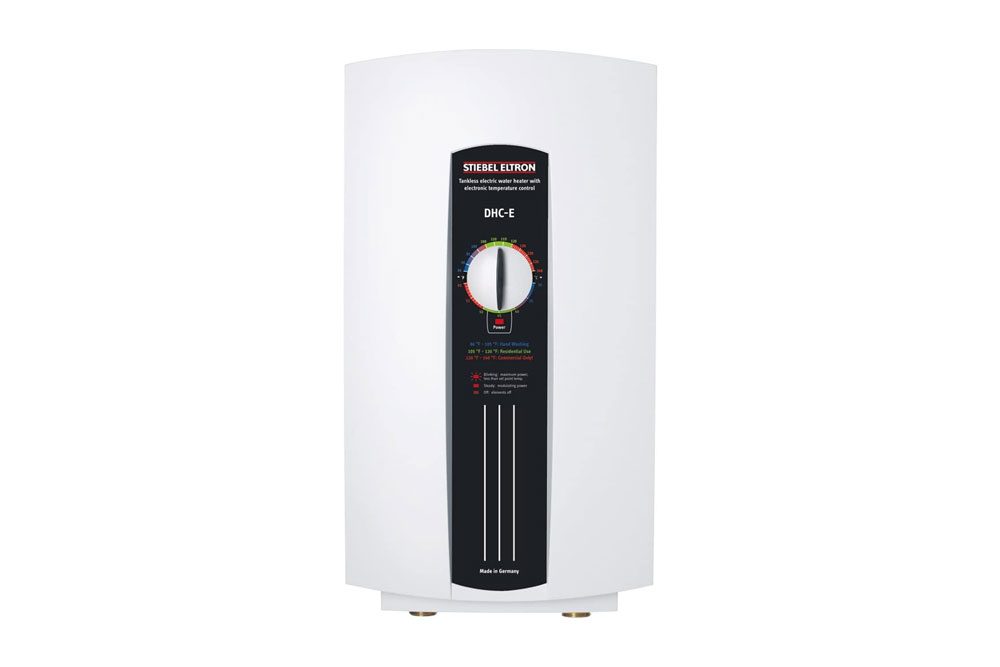
With 9600W of tankless heating, there’s plenty of horsepower under the DHC-E8/10’s hood to supply single or multiple basins, or in some cases even low-flow overhead showers. Two-stage operation allows you to cut the power down to 7200W for greater efficiency in areas with warmer mains temperatures. You never have to worry about scalding either, as you have full control over the temperature output–just turn the dial between 30° and 60° and rest easy.
Usually with tankless unvented water heaters, you’re a bit at the mercy of the pressure in your mains to determine the flow of hot from the tap. Not so with Stiebel Eltron, as their Electronic Temperature Control unit uses patented microprocessors to constantly monitor changes in mains pressure, and adjust the heating element accordingly.
Worried about durability and maintenance? Don’t be–Stiebel Eltron offers perhaps the best warranty in the business. By default, their products are covered under a 2-year, no-questions-asked guarantee, but there’s an option to pay a nominal fee to extend that up to 7 years. With IP24 waterproofing and superior hydroelectric insulation, you’ll never have to worry about moisture ruining the electronics of your trusty water heater.
Pros:
- Attractive, compact design allows for over- or under-sink installation
- Stiebel Eltron is a trusted brand and a pioneer of tankless water heaters
- Advanced thermostatic stabilisation ensures consistent performance, even with low pressure mains
Cons:
- It’s not cheap
2. Hyco Speedflow SF15K
If you’re looking for a ventless tank-storage water heater compact enough to fit under your sink–but attractive enough to mount above, as well–Hyco’s Speedflow SF15K deserves your consideration. At just 10kg and 53 x 31 x 28cm, it manages to pack lots of performance in a small body.

With its 15L tank and 2000W heating element, the SF15K has more than enough capacity to serve your cloakroom, kitchen, or workshop basin with aplomb (or even several of these simultaneously). The tank features glass-lined insulation for improved thermal efficiency, and you can expect to use about 555kWh per year.
While you’ll need to a hire professional help to install the SF15K, you’ll find the job has been made much easier (and cheaper) by Hyco. Not only did they graciously pre-wire this unit with the necessary 1.5m copper cable, but they also outfitted it in an IPX4 shell that allows greater freedom to position the SF15K anywhere in your home. It has wide compatibility, accepting mains pressure as low as 0.5 bar up to 4.2 bar.
Once installed, the SF15K is very much “set it and forget it” operationally. There’s a smooth-glide rotary dial than controls the thermostat, ranged up to 75°. When you expect a freeze or to be gone for extended periods, there’s also a simple on/off switch that doesn’t attempt to hide itself in an awkward position. To say it is whisper-quiet is actually doing the SF15K an injustice; at just 15dB, you’ll barely be able to hear it over your own breath.
Pros:
- Reasonably priced, with ready availability of replacement parts from Hyco
- Solid 1-year warranty on parts and labour
Cons:
- Energy Class B rating isn’t Class A
- Heating elements fairly vulnerable to corrosion, and need to be replaced every 12 months
3. Crown CPU 10 Compact Plus
If you’d simply rather by British, then the CPU 10 Compact Plus from Crown may be just the ticket. With a 10L tank, the CPU 10 can adequately supply one or two basins with ample water for handwashing or light dishwasher. What’s more, when you run out the tank, it refills and reheats fast (within 20 minutes) thanks to its oversized 2200W heating element.
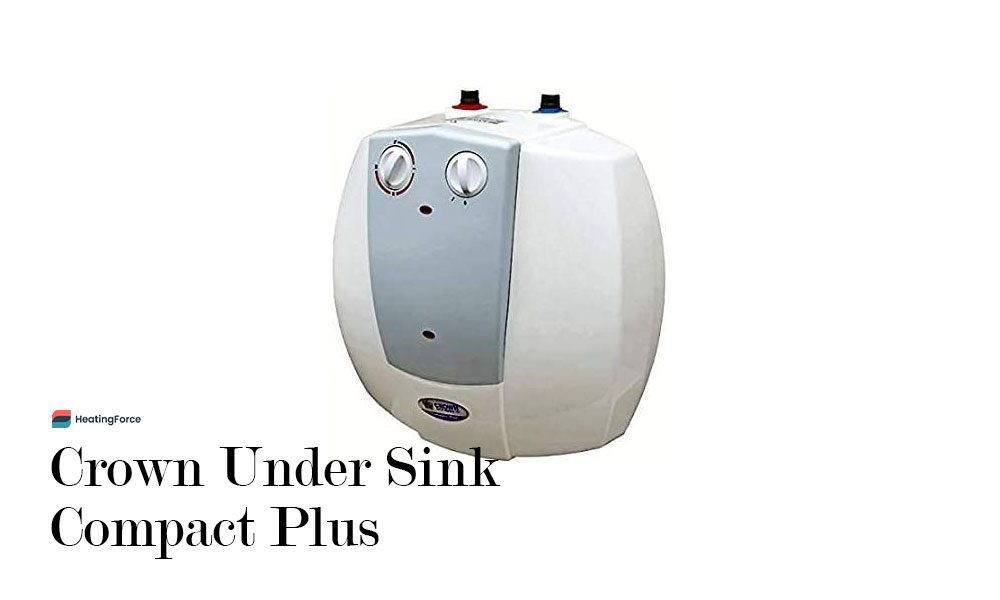
While maintenance of tank storage water heaters is inevitable, Crown has made the task much easier with thoughtful design choices. Chief amongst these are the nickel-plated, flanged immersion heating element, which resists corrosion and removes easily. A plus-sized sacrificial anode (equally easy to replace) effectively keeps the glass-lined, mild steel tank safe from corrosion for a longer service life.
What’s more, Crown offers a sterling 2-year warranty on your purchase of the CPU 10. If service is required, their team is actually based in the UK so they are actually able to render meaningful assistance without having to go through unreliable third parties.
We find the Crown CPU 10 to be fairly handsome, with its rounded hard-shell body. Two rotary knobs adorn the front of the unit, controlling temperature output (from 18° to 68°) and on/off. There are twin corresponding neons, which indicate when the unit is actively heating up, and when it is on, respectively. While there is overheat protection on board, you won’t have to worry about false lockouts thanks to the CPU 10’s extremely precise high-limit thermostat.
Pros:
- You’re buying from a UK company, with a great warranty and local technical assistance
- Maintenance is made extremely easy thanks to smart design choices
- Heats up fast
Cons:
- While the CPU 10 comes pre-wired and has a safety valve in the box, you’ll still need a PRV, non-return valve, and mini expansion vessel to complete installation
4. Redring RP1 Powerstream
If you’re not familiar with Redring, you’ve almost certainly heard of their parent company: GlenDimplex. As such, the RP1 is an unvented, instantaneous water heater of exceptional quality. Redring even stands by their product with a 2-year warranty, so you can buy in confidence.
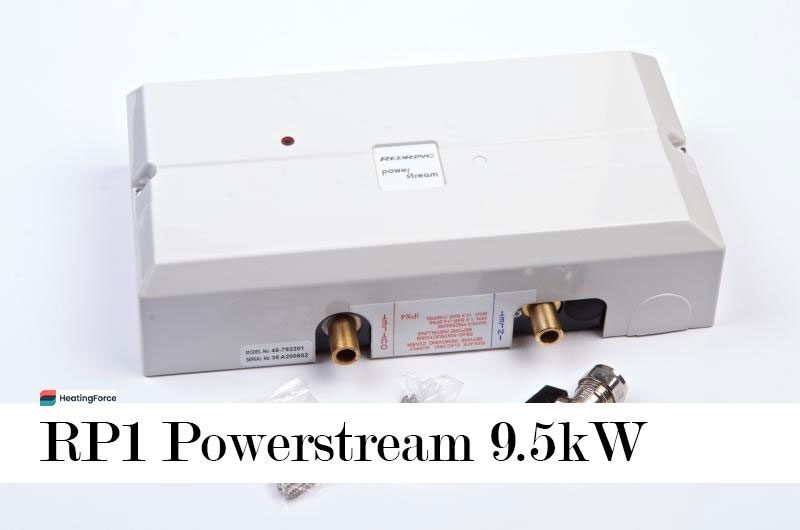
So what makes the RP1 special? In a word, flexibility; wherever hot water is needed, the RP1 is ready to serve at the point of use or even remotely.
On its own, the RP1 is a featherweight 2.2kg, and just 18.5 x 8.3 x 37.4 cm, allowing it to slot in almost anywhere. But Redring’s trump card here is undoubtedly its ability to mount upright, or turned 90°. The orientation has zero impact on performance, and you even have the ability to wire the RP1 out the back or side of the unit for a neat install.
In terms of performance, the RP1 is exceptional, with a powerful 9500W heating element and twin outlet. In fact, it is robust enough to supply either two basins, or a single basin and shower simultaneously (though this requires Redring’s Powerstream Mixer Accessory Kit). There’s electronic flow regulation as well, so even if your mains pressure fluctuates, your hot water will remain stable.
Pros:
- A powerful unvented water heater, with fast heating response
- Flexible installation
- Thermal cut-out for safety
- Class A efficiency rating
Cons:
- Incompatible with thermostatic mixer valves and taps
- Not particularly gorgeous
5. HEEPPDD Mini Water Heater
Another highly flexible unit, the Mini Water Heater from Chinese manufacturer HEEPPDD is worth a second look. Sure, it doesn’t have name recognition on its side, and there’s no reliable warranty to speak of. But the Mini Water Heater can be had for not a lot of money, yet still produces admirable results.

HEEPPDD’s unvented tankless water heater offers instantaneous hot water delivery between 30-55°, with its 5500W heating element. Though the manufacturer is somewhat tight-lipped on the matter, there is definitely some sort of thermostatic stabilisation; evidenced by the fact that we got reliable flow rates at 40°.
The Mini Water Heater is also surprisingly well-equipped in terms of safety features. There’s triple-redundant hydroelectric insulation, plus a thermal cut-out and an anti-dry sensor to protect against overheating. The leak-proof case also features IPX4 moisture resistance, lending itself to installation anywhere in the home or office.
And indeed, it’s quite small in stature, and attractive enough to mount above or below the sink. If you choose the latter, you’ll appreciate the digital temperature display that reads easily in the dark and controls easily anywhere. To save power, the HEEPPDD shuts off after a period of inactivity, and springs back to life whenever you use the tap. It’s really quite convenient!
Pros:
- A lot of bang for buck
- Good safety provisions
- Flexible installation
Cons:
- HEEPPDD is likely just a middleman for the anonymous Chinese manufacturer
- Online sellers offer purchase protection, but there’s no real warranty
- Limited operational temperature range
6. Triton Showers T30i Handwash
Triton Showers are no strangers to best-of water heater lists, and their T30i offers a compelling reason why. At its price point, no other water heater offers the same level of performance or reliability. This is why it’s commonly found in multiples throughout commercial complexes, not to mention homes.
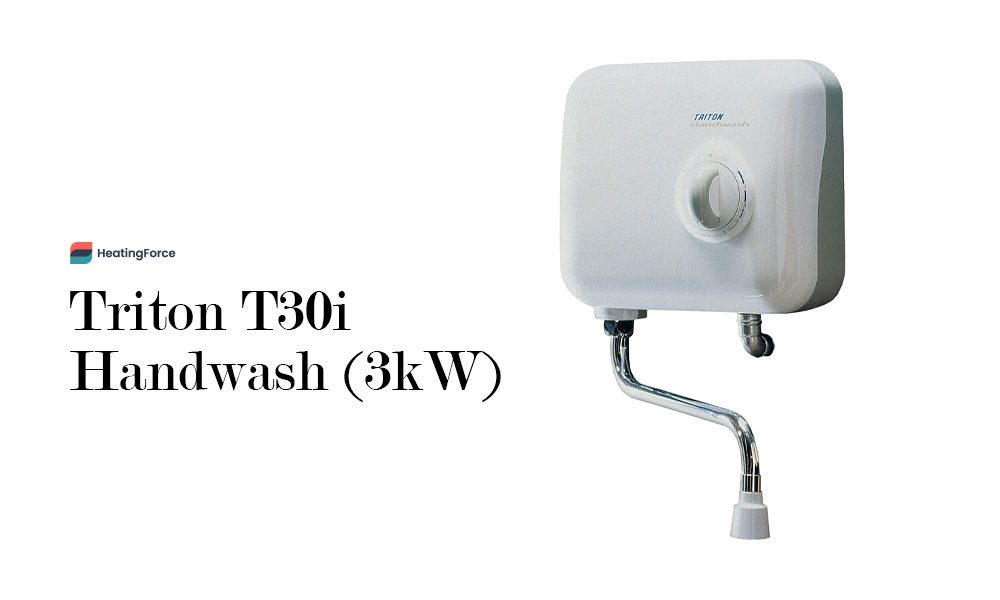
Wherever central water heating can’t reach, there’s the T30i. It features simple plumb-in, plumb-out installation, and its 3000W heating element doesn’t require special wiring to prevent the fuse box tripping. The 200mm shower arm allows for optimal dispensation, even in cramped quarters.
Its modest 8L/min flow won’t suffice for heavy duty, but it’s not meant to. Triton Showers were smart to include temperature stabilisation in such a small unit, as otherwise performance would really suffer with the slightest variation in mains pressure. The T30i drops right into high-pressure water systems up to 10 bar.
Controlling the T30i is as simple as turning a knob in the desired direction. There’s no fancy digital display hooked into a sophisticated thermostat, so you have keep a relative mind set when making temperature adjustments. As is, the T30i performs admirably for what it is–and is better-built than it has any right to be for the price. Triton Showers even guarantees your purchase with a 1-year warranty on parts and labour.
Pros:
- Excellent performance for half the price of other unvented water heaters
- Uncommonly good warranty on such an inexpensive unit
- Miniscule footprint allows for easy installation anywhere
- Discounts available for purchases of multiples
Cons:
- Heater will not perform nearly as well in particularly cold climates
- Flow rate is moderate in the best of conditions
7. Triton Showers Seville
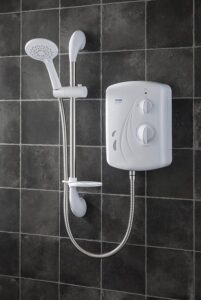
Triton Showers strike again with another purpose-built unvented water heater. This time, we’re looking at the Seville, which has carved out its niche as one of the best-selling electric shower heaters on the market.
The Seville solves a problem that has plagued mankind as long as indoor showering has been a thing: running out of hot water. Whereas tank storage heaters have a definite amount of hot water they can produce, the Seville simply heats the water as you use it. This means hot water on demand, for as long as you like!
There are four models of the Seville: 7500W, 8500W, 9500W, and 10500W–each occupying a different price point. If you’re looking for a steamy shower, however, we recommend you just go for the most powerful. The price difference isn’t so vast that it justifies missing out on the ability to take a piping hot shower, even in the dead of winter.
The Seville has separate temperature and flow controls, and the head offers three distinct spray patterns. The 1.25m chrome hose is designed to prevent twisting and tangling, and there’s also an easy-install riser rail to perfectly position the head how you like. No more dropping the soap, as there’s also an integrated soap dish for your convenience.
A double temperature protection system simultaneously monitors fluctuations in temperature output and adjusts accordingly, whilst a separate sensor ensures the heating element never runs to unsafe temperatures. The Seville boasts a Class A energy efficiency rating, and thus provides hot showers that run out neither your water tank nor monthly utility budget.
Pros:
- Attractive, lightweight, and highly functional shower unit
- 2-year warranty makes an easy purchase even easier
- Multiple power ratings available to fit your needs
- Compatible with combi boiler system
Cons:
- Spray pressure could be greater
Vented vs. unvented water heaters: What’s the difference?
If you’ve only got a moment to read anything that isn’t a product description, the short answer is this: Unvented water heaters are a little more expensive, but in most cases provide much better water pressure than vented units. Otherwise, read on for a more in-depth explanation.
How vented water heating systems work
Diving into the topic a bit more, we learn that vented water heaters take up more space in the home, yet still generally offer less impressive performance. Here’s how it works:
- The mains pumps water into a special tank, which is located somewhere physically above your water heater.
- This tank feeds water down into your water heater using gravity, via a pipe known as a “vent”. The purpose is to normalise the level of water pressure where it might otherwise be insufficient.
- Your water heater receives this normalised flow of water, heats it up, and delivers it to you through the tap or shower. Venting is useful in that it gives excess pressure from the expansion of heated water someplace safe to go that won’t damage your piping.
You typically see vented systems in older homes, as they’ve been the default for ages. What’s more, they’re useful when the mains pressure isn’t great, or you’ve got an alternative way to collect water into the tank. What’s more, vented water heaters can allow you to still enjoy a limited amount of hot water, even if the mains shut off for some reason, as there’s water on reserve for the heater to use at all times.
How unvented water heaters work
In contrast to vented systems, unvented water heaters hook directly into the mains. As such, they produce a similar amount of water pressure out the tap as they receive from the mains. In most modern plumbing scenarios, the benefits are immediately obvious, as mains pressure tends to be quite good in most urban and suburban areas.
Comparing the two
If you live in such an area, there’s no practical reason to choose a vented heating system, besides initial cost. Mains pressure will almost always be better than that produced in a vented system. What’s more, because there is no tank, you don’t have to worry about your hot water reservoir freezing over in the winter.
So, if there’s no tank, where does all that excess pressure from heating go? Any half-decent unvented water heater will feature some sort of internal expansion unit or functional equivalent. Most will also ship with pressure relief valves. The better water heaters will have dual thermostats, which monitor the differences in temperature (and thus, pressure). These then make adjustments to the heating element’s output to remain within safe parameters.
The point is, there should be no concern for your pipes with a properly installed unvented water heater. Provided the baseline pressure in your mains is sufficient, you’ll enjoy improved flow rates from your water heater, and more consistent heating to boot. The upfront cost is a bit more, but not so dramatic that it balances out the hit to performance you take with a vented system.
How to pick the right unvented water heater – A buying guide
Now that you understand the intricacies of how unvented water heaters work and taken a look at some of the best examples on the market, you have a stronger baseline for comparison shopping.
To better equip you still to make a smart purchase decision for your home, we’ve put together a brief buyer’s guide on how to pick the best unvented water heaters. You’ll learn about the criteria we used to compile our list of recommendations, and how to separate the winners from the duds available online and elsewhere.
Tankless vs. tank storage water heaters
Choosing vented vs. unvented is just the first step in finding the idea water heating system for your home or building. Another meaningful decision is between tank storage and tankless water heaters, both of which can be vented or unvented.
Tank storage – Reliable but limited, cheap, traditional
Tank storage heaters are the traditional option, and often see decades of usage. They’re reliable, though only if you keep up with the maintenance of periodically replacing the sacrificial anodes that guard the tank against corrosion, as well as the heating element itself. They offer a highly consistent flow of hot water in terms of both temperature and pressure, as it’s kept on reserve to be dispensed as needed.
Of course, this is a blessing and a curse; once you run out of water in the tank, you’ve got to wait until it refills to get hot water again. If you’ve ever had the shower run out of heat, you know how inconvenient this can be. What’s more, there’s a fair amount of energy expended to heat the tank up in the first place, plus more still to maintain the temperature on standby.
Tankless – Instantaneous heating, more expensive, modern
In contrast, tankless water heaters heat only the water you need, as you need it. Tankless units typically have higher-wattage heating elements that draw more energy than their tank storage counterparts. However, this balances out favourably with the long-term savings of not having to maintain a full tank of hot water, which you may or may not use.
Tankless heaters are more compact, and typically easier to install. They are not, however, exempt from regular maintenance, and are indeed a bit more expensive to service. You’ll need to hire a professional to descale your unit, and you’ll want to plan for this at about once a year.
Overall though, if your budget can accommodate the higher purchase and install costs, you’ll save money in the long run with a tankless water heater. What’s more, you’ll never run out of hot water when you need it! Just make sure that you select a unit with sufficient power to adequately warm your mains, as some climates are much colder than others.
Look for safety features
The amount of heat needed to warm or boil water is considerable, and as such requires some extra features to ensure it doesn’t pose a danger to you or your property. Here are a few:
Anti-dry
If there’s no water surrounding the heating element, there’s nothing to absorb all that heat except for the water heater itself. This can cause components to warp, allowing for leaks that get into the electronics, risking burnouts or even electrocution and fire. Anti-dry protection usually makes use of a floater or sensor to ensure the unit cannot power up in the absence of water, preventing a dry burn.
Thermal cut-off
Whether it’s a power surge or electronics gone wrong, the operational temperature of your hot water heater can exceed safe parameters, posing risk of scalding or fire. A thermal cut-out, also known as overheat protection, makes use of a sensor that shuts down the power before the temperature reaches unsafe levels.
Hydroelectric insulation
All electric water heater designs should show significant thought and effort to keep the electronics apart from the water system. The best manufacturers are proud to advertise their innovations here, so it shouldn’t be a hard thing to check into. What’s more, you should always ensure the casing bears at least an IPX4 moisture resistance rating, otherwise you risk an errant splash shorting out your water heater.
Thermostatic stabilisation
Virtually every water heater will allow you to control the heat output. However, variances in mains pressure may cause temperatures to fluctuate. Imagine your water pressure drops suddenly with a tankless heater: all of a sudden 9000W of heating go into perhaps half the volume of water, bringing it to a much hotter temperature than you’ve specified.
Thermostatic stabilisation combats just this scenario, and employs sensors to compensate for fluctuations in mains pressure and temperature. That way, if you select 40° water, you get 40° water instead of scalding or frigid cold.
Don’t ignore the warranty
Most reputable manufacturers offer warranties on their products. The typical period is 1-year coverage on parts and labour, though it’s not uncommon to see 2-year guarantees as well. Select few offer the option to pay for extended warranties, as well.
In almost every case, you’ll need to register your product purchase to make good on your warranty. This takes a few minutes, but can save you a bundle repairing or replacing a defective unit.
Warranties typically don’t cover filters, sacrificial anodes, or heating elements. And indeed, you’ll need to keep up with regularly replacing these parts in order to maintain your warranty. What’s more, professional installation is required to validate your warranty–though you’ll want to hire a technician anyway for convenience and safety.
Wrapping up
If you’ve read this far down the page, congratulations! You are now well-positioned to pick a highly efficient unvented water heater for your home, office, or any other point of use cut off from the central boiler.
We’ve recommended seven of the best unvented water heaters across a variety of niches and price points. You’ve also learnt the key criteria needed to make the most informed purchase decision.
Got any questions or comments about vented, unvented, tank storage, or tankless water heaters? Sound off in a comment below, and we’ll answer promptly.